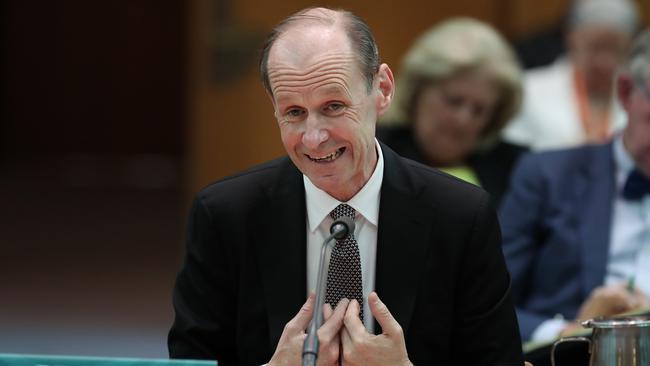Banks warn of ‘grinding’ recovery from pandemic
Two of the nation’s big four banks are predicting house prices will fall in a range of 10-15 per cent

Two of the nation’s big four banks are predicting house prices will fall in a range of 10-15 per cent, as the nation “grinds” its way out of the pandemic-induced recession.
Appearing before the House economics committee on Friday, Commonwealth Bank chief executive Matt Comyn said the property market has only drifted slightly lower.
This was after a strong performance in the year to July, with Sydney prices gaining 12 per cent and Melbourne lifting by 9.5 per cent.
“So a fall of 10-12 per cent, given where the market is and how strongly it has performed in recent times, is entirely manageable,” Mr Comyn said.
In earlier evidence, ANZ Bank chief executive Shayne Elliott forecast a 10-15 per cent slide in house prices.
Mr Elliott said the economy would grind its way out of recession, and he had never believed the pundits who said the recovery would be “V-shaped”.
The economy, he said, would bottom out sometime before the end of the year but GDP would not match pre-COVID-19 levels until some point in 2022.
As an open economy with a heavy reliance on a free flow of goods and people, Australia faced a challenging period.
Mr Comyn said CBA’s forecasts were broadly in line with those of the Reserve Bank, with GDP expected to shrink 4.5 per cent this calendar year and expand 1.75 per cent in 2021.
Unemployment would peak at 9-10 per cent in the December quarter.
Official data confirmed this week that the economy reversed by a record 7 per cent in the June quarter due to a collapse in consumption.
The crunch was more than three times worse than the previous record contraction of 2 per cent in 1974.
After a 0.3 per cent decline in March quarter GDP, Australia met the technical definition of a recession — two consecutive quarters of negative growth – for the first time in 29 years.
The banks are expecting a short lag before they feel the sharp edge of the downturn around the middle of next year, after the government support packages wind down.
Mr Elliott said he had been having discussions with his senior executive team and the board about scaling up for next year’s expected wave of personal and business insolvencies.
“We don’t predict the future; we prepare for all eventualities,” he said.
“It’s a question of how to scale it up and make sure we (act) in an ethical and appropriate way.”
The ANZ chief rejected suggestions that the pandemic was a “black swan” event that could not have been predicted. Financial crises, he said, occurred every seven to 10 years on average, and while the causes appeared different the fundamentals were essentially the same in that customers had suffered a significant hit to their incomes.
One of the big differences about the virus was its non-discriminatory nature, with the impact felt right across the country, in most segments and up and down the socio-economic hierarchy.
But the impact was mitigated by the government acting much faster than in previous shocks, such as the global financial crisis in 2008.
“If we look ahead, we remain cautiously hopeful about the economy,” Mr Elliott said.
“Even though the streets of Melbourne are empty today, there are emerging bright spots around the country, like agriculture and resources.”
Mr Comyn said the size of the economic contraction was less severe than first anticipated, but the nation faced a “long and uneven” recovery.
“We see the task of finding new employment opportunities as one of the country’s highest priorities,” he said. “Deferrals and other support measures have played a vital role, but new jobs will be integral to a sustainable recovery; so it is vital our lending supports investment and job creation.”
Asked what it was that kept him awake at night, Mr Comyn said the prospect of a much higher unemployment rate and a bigger fall in house prices as a result.
One of the big influences on how the future would pan out, he said, would be the level of income support for the economy, which would have to be tapered.
Fiscal stimulus would also loom large, because the performance of CBA was ultimately tied to the underlying level of economic activity.


